The combination of aging joints and excessive heat compel me to periodically interrupt my morning walks and seek a shady refuge where I can sip some water and just take in the scene.
Looking south at sunrise over the local south Florida wetlands:
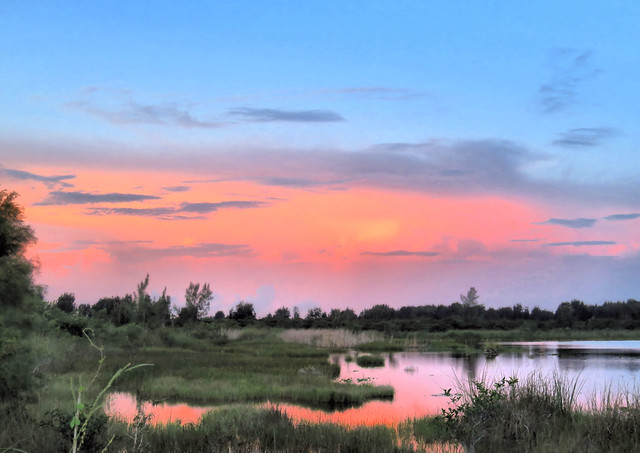
One benefit of sitting still is that I am less of a disturbance to wildlife. I am also a bit more attuned to what is going on about me.
This was the case when I noticed that a Loggerhead Shrike was interacting with a Northern Mockingbird. Every time the shrike hovered over a small bush the mockingbird immediately attacked it.

This happened several times, so I assumed that the mockingbird was protecting its nest or one of its young from the "Butcher Bird."

However, the object of the shrike's attention was actually a fledgling Northern Cardinal:
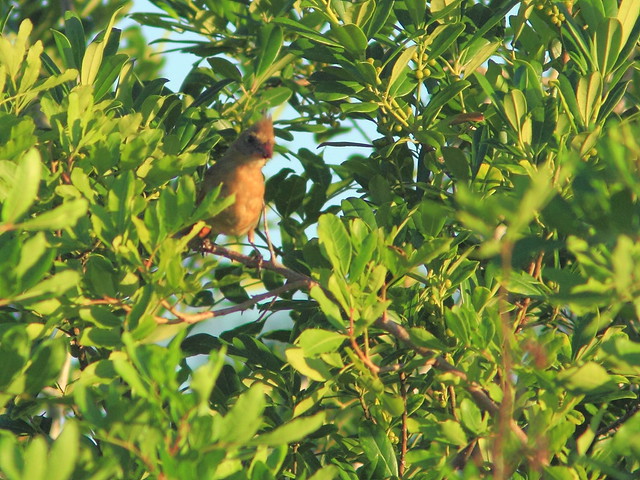
A few more mockingbirds had joined the fray, and a Blue Jay was calling incessantly. This attracted other jays and they, too made swipes at the shrike.
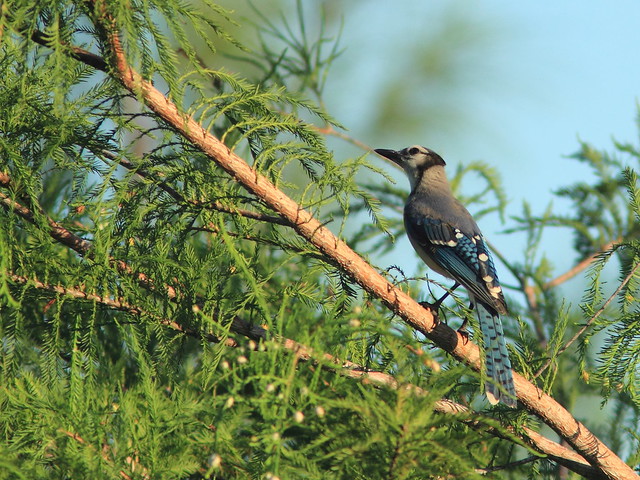
The little cardinal is visible to the left in this photo:
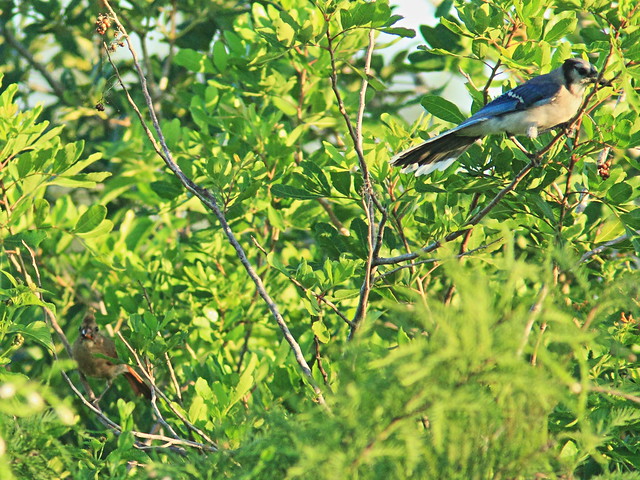
Interestingly, a single adult female cardinal moved about excitedly but did not join in attacking the predatory bird.
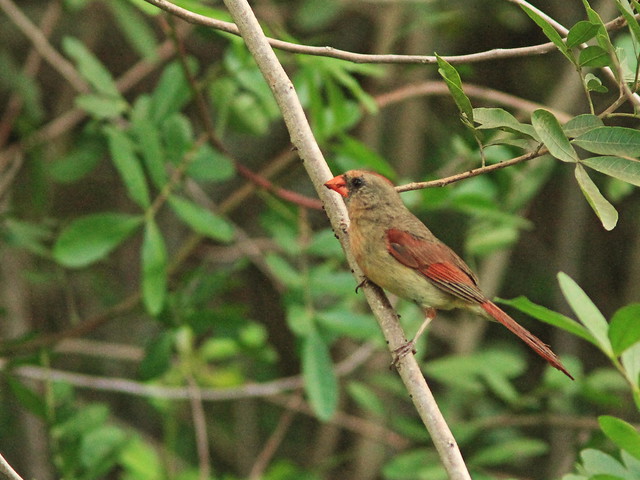
The shrike retreated ...
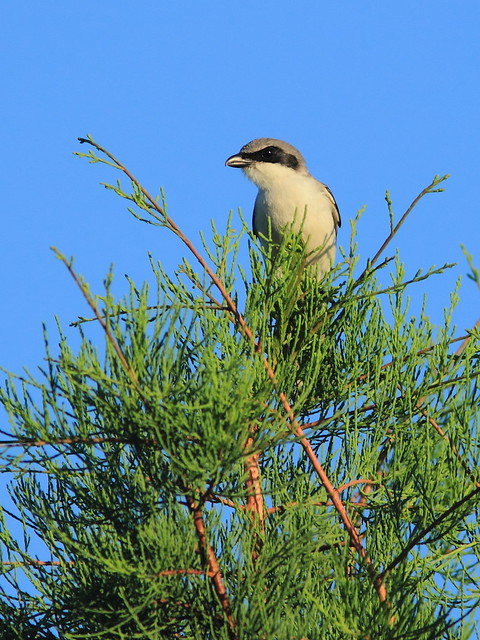
...and the young cardinal came out into the open:

Before our neighborhood was drained, filled and built out some 15 years ago, locals hunted wild pigs in what was then swampy agricultural land. Some of the old trails were said to have been created by hunters of feral pigs. However, despite hiking and birding here frequently I never found evidence of a porcine presence-- until this year.
The first signs that suggested that pigs may have invaded were copious piles of odoriferous feces... or were they possibly those of a bear?:
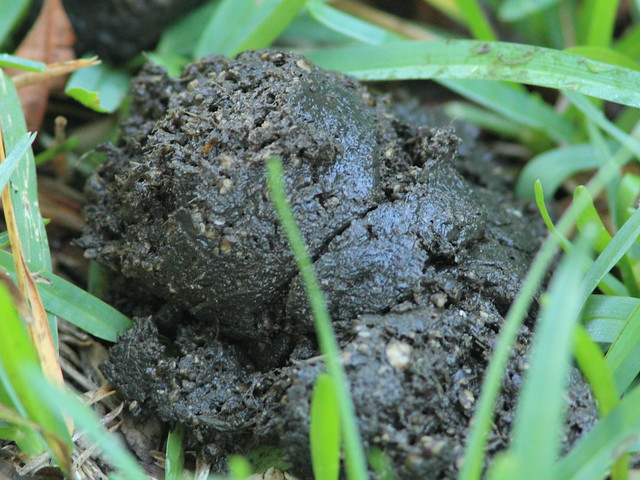
Then, one dark morning well before sunrise I ventured a short ways down a side trail to the edge of a wet meadow, hoping to surprise a night-heron or maybe a deer. Instead, I made out the form of a dark creature. It was moving very slowly as if grazing:
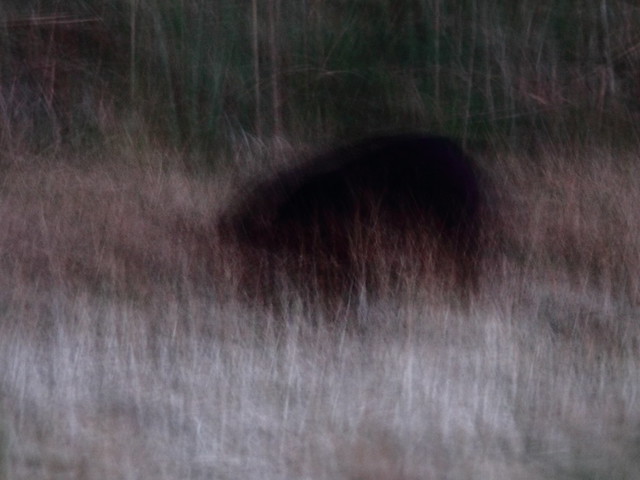
I first thought it was indeed a bear. I quietly watched until the light improved, when another very poor photo reassured me that it was only a pig, but quite a large one:
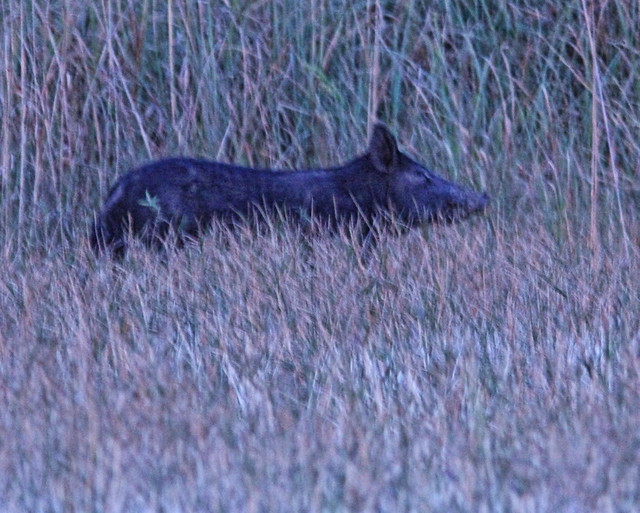
My suspicions were thus confirmed. So far I have found at least two sets of pig tracks, one with hooves that were 3 inches long and others which measured 2 inches. The scat deposits have increased in number and volume, making me wonder how many are out there.
Since then, Mary Lou and I have seen the same animal three more times along the trail, always before sunrise and running away. I still have not gotten a decent photo because of the poor light, but am certain it is a male.
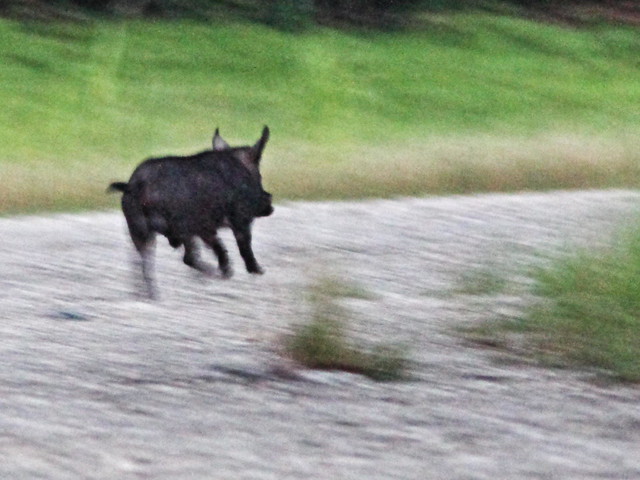
They can be aggressive, so I make sure to carry pepper spray.
This week the lake provided excellent reflections on still mornings. A Great Egret lifted off into the first rays:
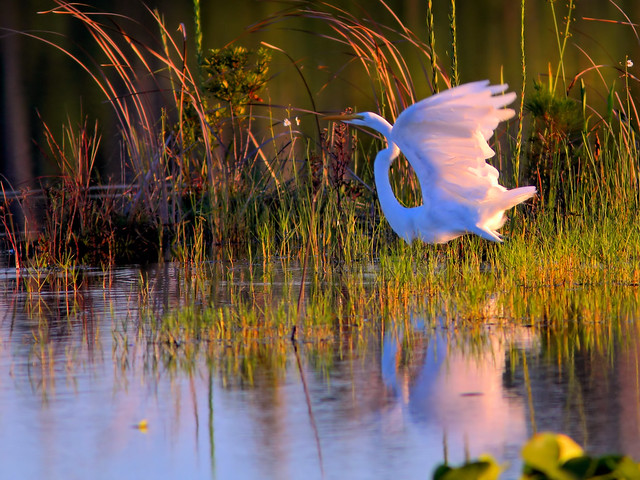
At nearby Chapel Trail Nature Preserve, the boardwalk served as my fence photo, though I was actually concentrating on the clouds:
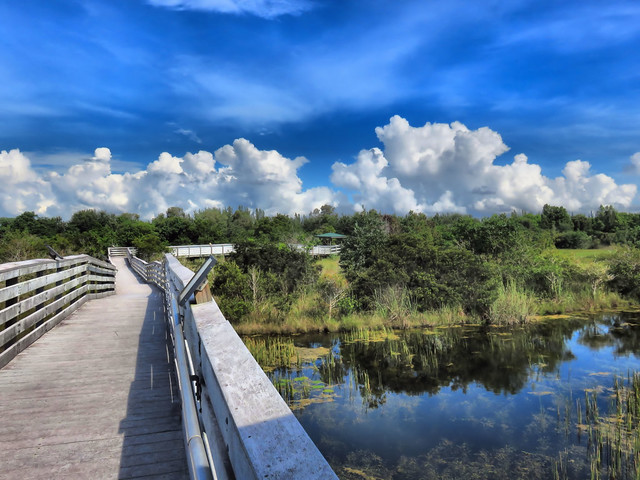
Thick patches of Bidens alba are in bloom, with tiny daisy-like flowers ready to produce millions of the little two-toothed nettles which cling to pant legs and socks-- "beggar's lice." (Bidens means "two teeth." Just realizing that is the name of our Vice President. I never noticed that about him!)
In Florida the lowly Bidens is an important source of nectar for honeybees and butterflies, in third place after non-native citrus and Saw Palmetto. It therefore deserves respect, which I will grant by trying not to walk through a patch after it goes to seed!
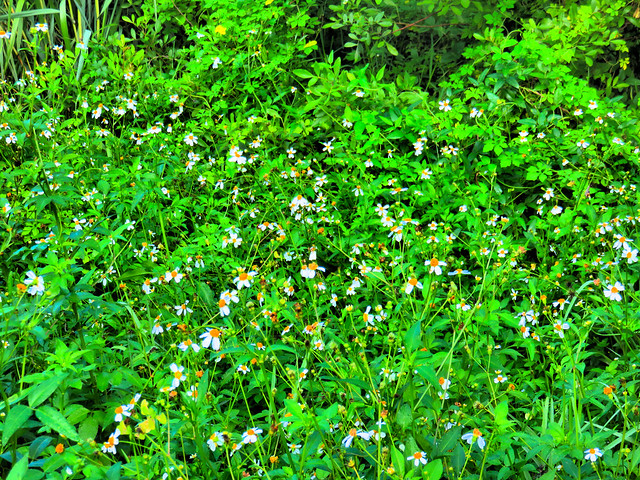 A female Julia heliconian sips nectar from a Bidens blossom:
A female Julia heliconian sips nectar from a Bidens blossom:
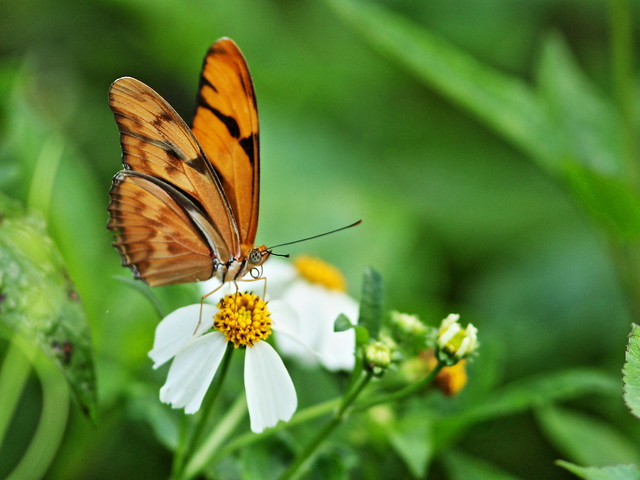
= = = = = = = = = = = = = = =
Linking to Misty's CAMERA CRITTERS,
Linking to Eileen's SATURDAY'S CRITTERS,
Linking to GOOD FENCES by Tex (Theresa).
Linking to SKYWATCH FRIDAY by Yogi, Sylvia and Sandy
Linking to WEEKEND REFLECTIONS by James
Linking to BirdD'Pot by Anni
Linking to Wild Bird Wednesday by Stewart
Linking to Today's Flowers Friday by Denise
Linking to Wordless Wednesday (on Tuesday) by NC Sue
________________________________________________
Please visit the links to all these memes to see some excellent photos on display
________________________________________________
Fog over the wet prairie on the morning of April 13:
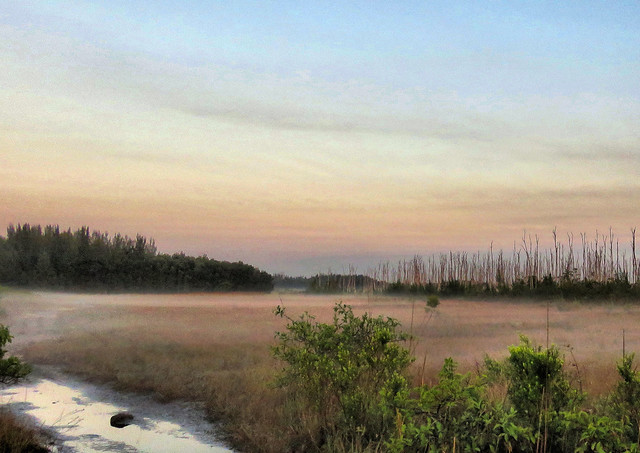
Before we departed Florida for our second home in Illinois, we were pleased to see receding water levels in our local wetlands. High water dilutes the prey upon which both sight feeders (such as herons and egrets) and tactile feeders (storks and ibises) depend. There have been widespread nesting failures of these species this season, as they do not breed if food is scarce.
Conversely, low water also discourages breeding because the birds benefit if their nest trees are in standing water. This deters terrestrial predators and encourages alligators which not only protect the nests but are rewarded when young birds fall into the water. Optimal breeding time usually begins around November and finishes before spring rains once again flood the wetlands.
An old cypress stump, which I call the "Enchanted Island," provides a convenient gauge of the depth of the water near the shore of the lake in our birding patch. By late winter it normally would be sitting on a mud flat.
In March, 2015 the water level was a bit above average because of late winter rains:

An unusually dry summer followed, and it was high and dry by July, 2015:
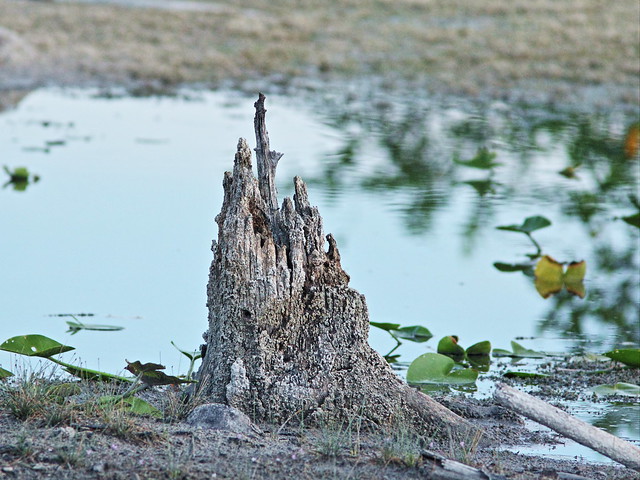
Then the record-setting winter rains came, and by December, 2015, only the top of its spire appeared above about 3 feet of water:
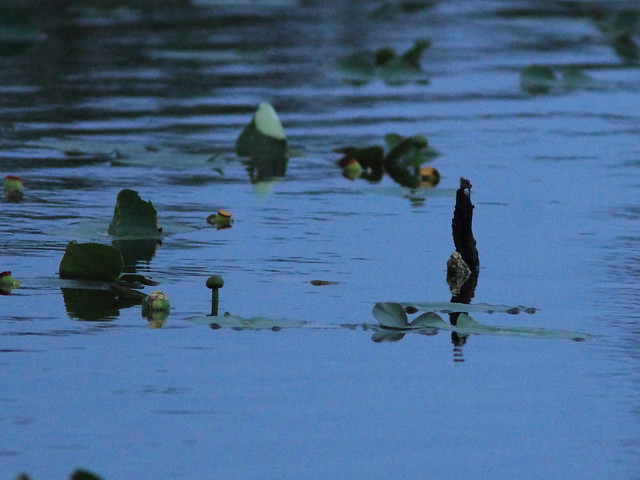
Here it was on April 12, 2016:
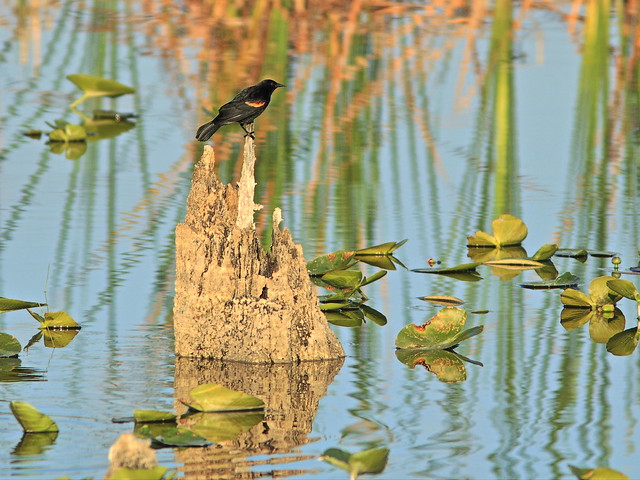
The newly created shallows now have attracted waders, including several Black-necked Stilts:
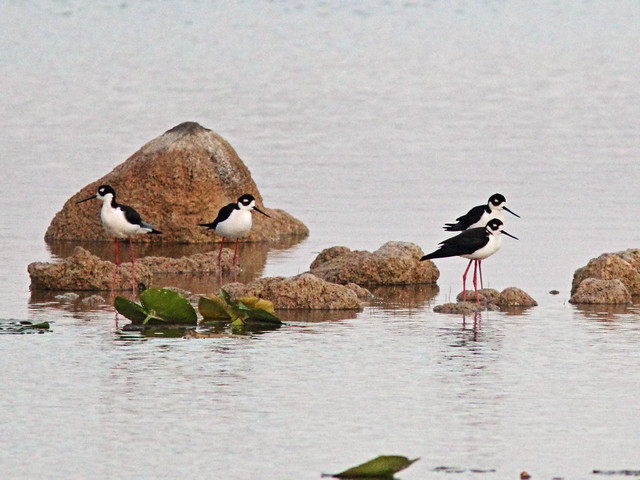
One arrived early on April 12. I first saw it during the "blue hour" before sunrise. My photo was very dark, so I nudged it to life by overlaying a series of lighter exposures from the original RAW image::
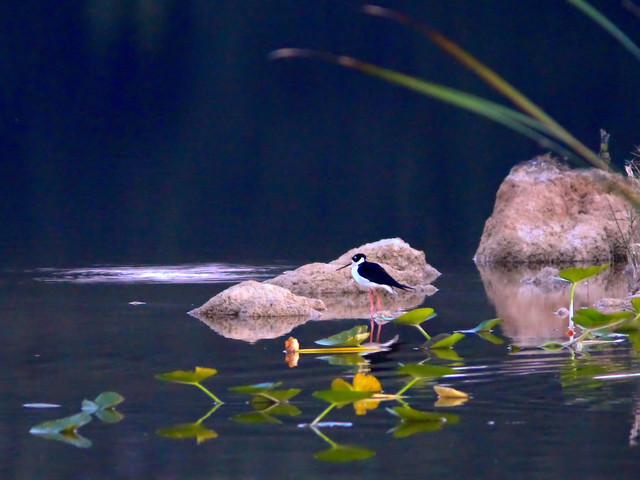
A bit later, while the sun was still low, a flock of five stilts foraged in the shallows:
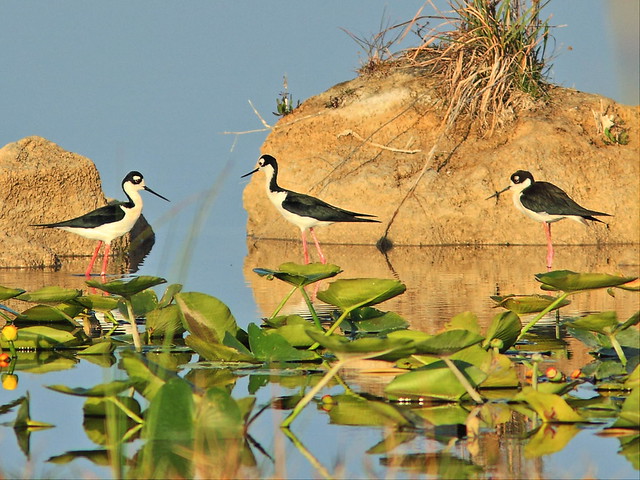
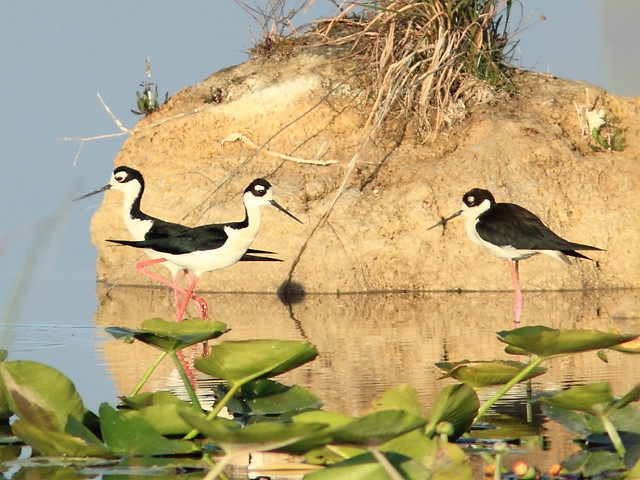
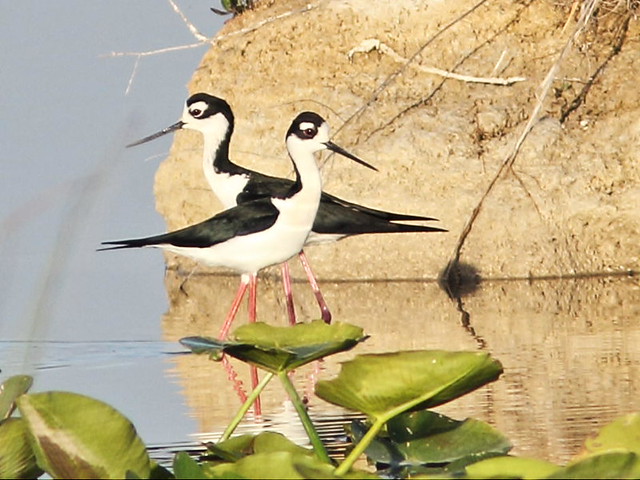
The eggs in a Green Heron nest, which I had been observing for about two weeks, began hatching during my last couple of days in Florida. At first (on April 13) I saw four chicks and one unhatched egg. In this photo the parent is feeding them regurgitated fish particles. The egg is a beautiful blue color:
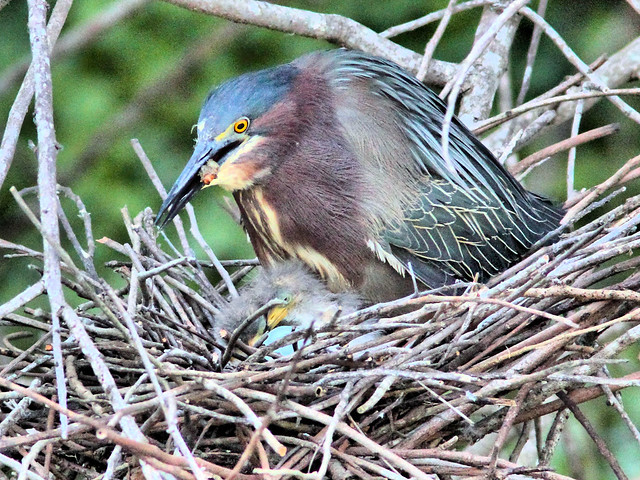
The next day I counted five hatchlings:
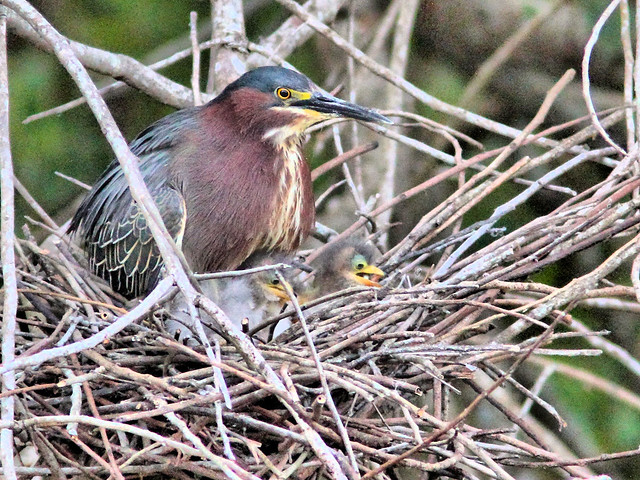
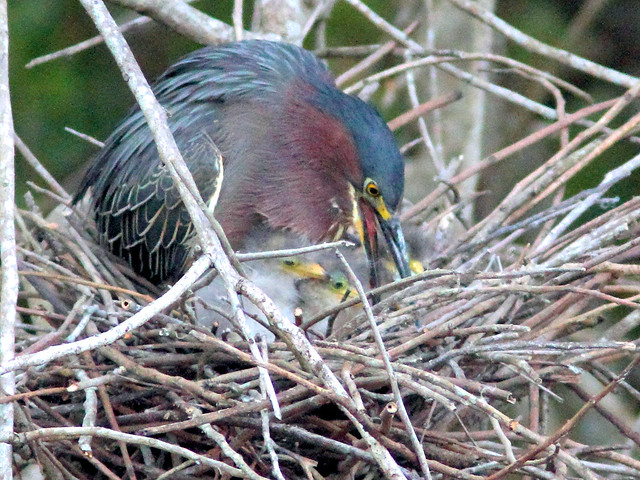
The nest is in plain sight over the water of a canal in the bare branches of an herbicide-treated tree and is exposed to the elements and predators. About 6 feet away and deeper amid the dead branches, a second pair was tending a nest still containing eggs. I am anxious about their safety.
Migrating warblers, including this acrobatic Black-and-White Warbler, started arriving just before our departure:
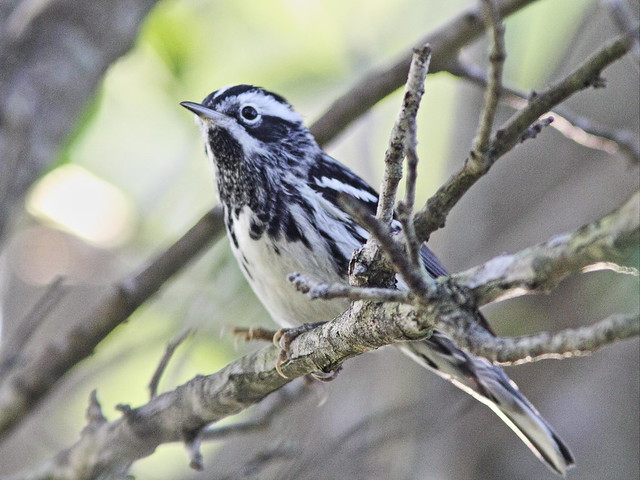
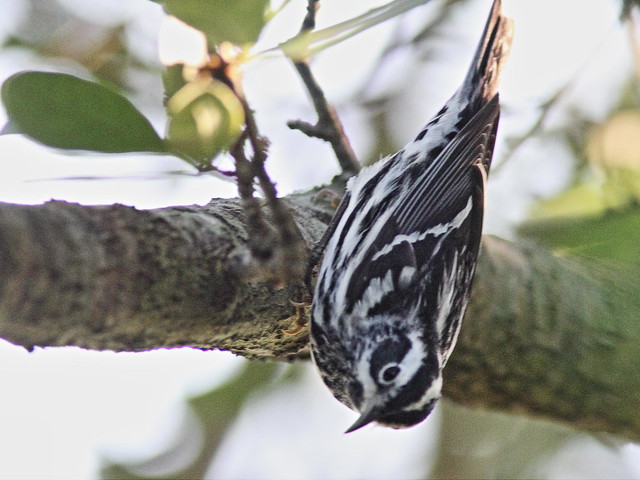
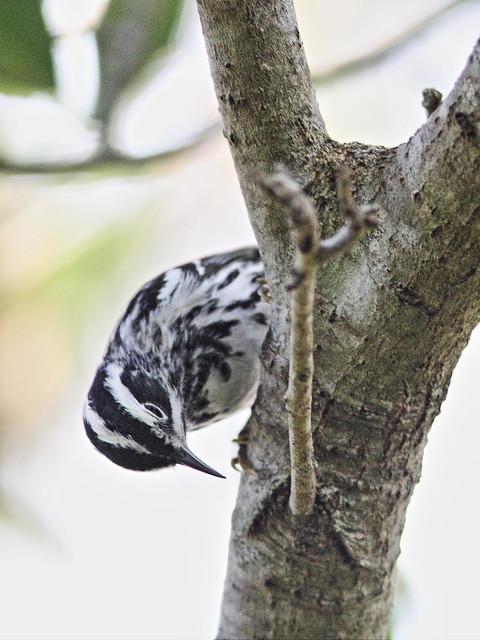
Other notable sightings provided nice "parting shots," including a Tricolored Heron in dawn's glow
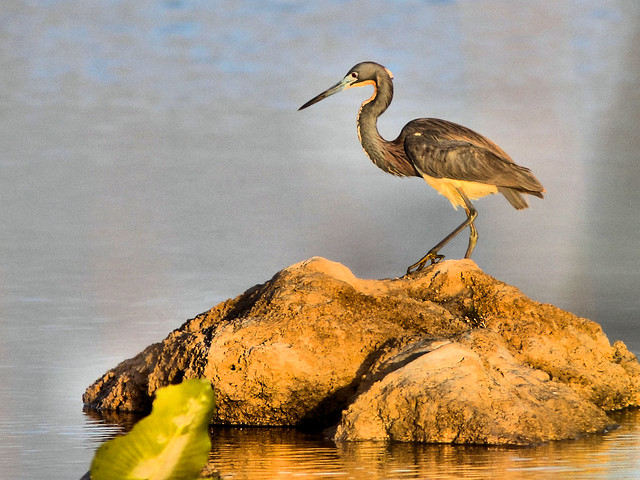
The first Caspian Tern of the season flew over the lake:
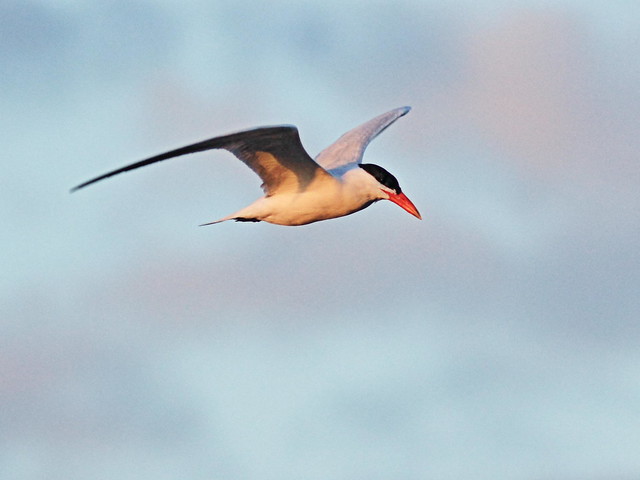
Least Terns also appeared on the lake, a sure sign that spring had arrived:
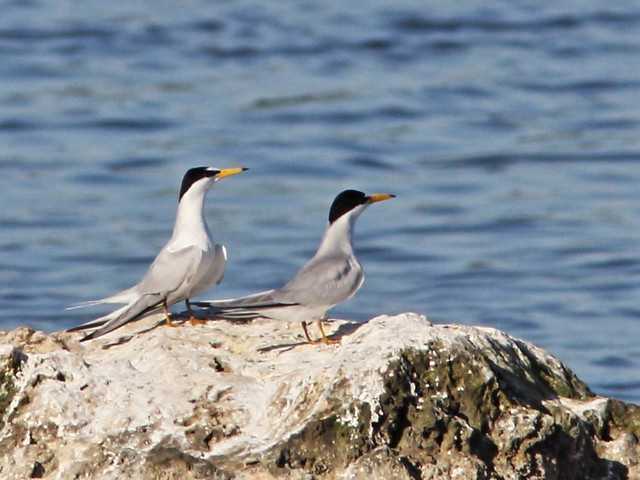
A flock of migrating Blue-winged Teal flew along the opposite shore (click on photo for enlarged view):
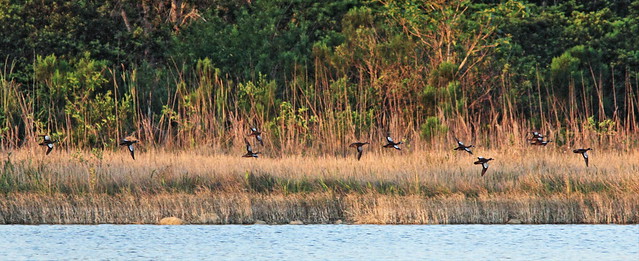
A pair of Mottled Ducks exercised their wings:
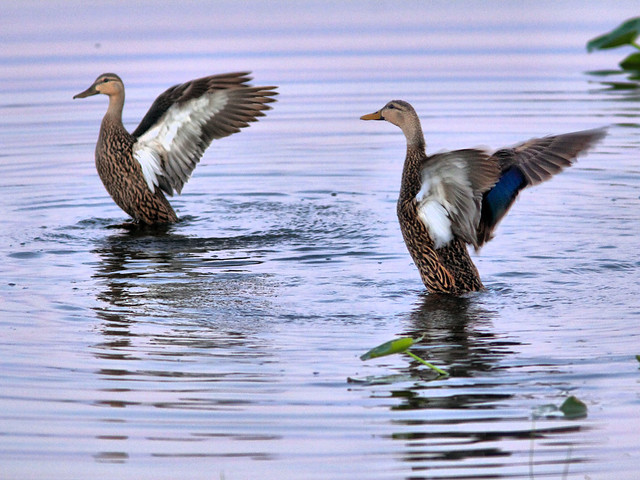
Sightings of the mammalian kind included these White-tailed Deer. The buck's antlers were in very early velvet stage, and one of the does appeared to be pregnant:
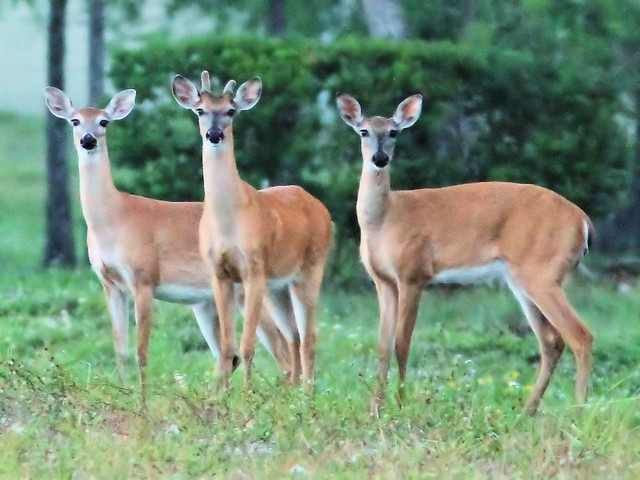
I got quite a fright very early one morning as I nosed through some brush to get a photo of the wet prairie. Suddenly I saw a large black creature not too far away. It was too dark for me to photograph or even make out its shape so I watched for a while as it moved slowly along the edge of the high grass.
Then I remembered that decreasing the exposure compensation permitted the camera to focus better in the dark. The prolonged exposure time also caused a blurred photo as I was not using a tripod, but it was good enough for me to recognize the creature as a large wild pig-- the first I have seen here over the ten years I have been walking the patch [This photo was taken a few minutes later, at Exposure Compensation Minus 1, ISO 3200 at 1/25 second]:
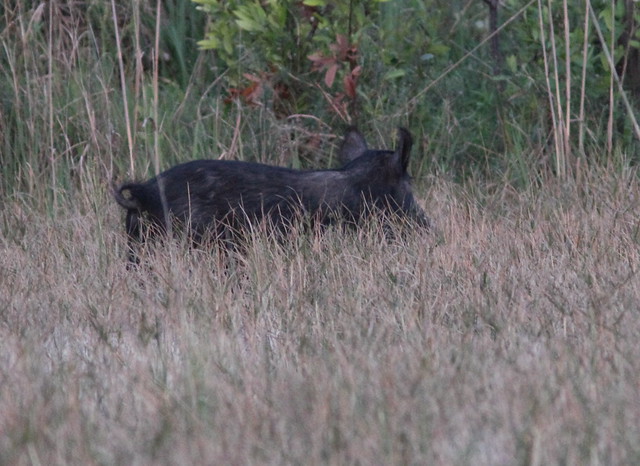
Looking for a fence picture for Tex's Good Fences meme, I found this one, of the lighthouse on the point at Sanibel Island on the Florida Gulf Coast. This was taken just after Easter, when we spent a few delightful days there with our Illinois granddaughters and family. It is processed as an antique oil painting:
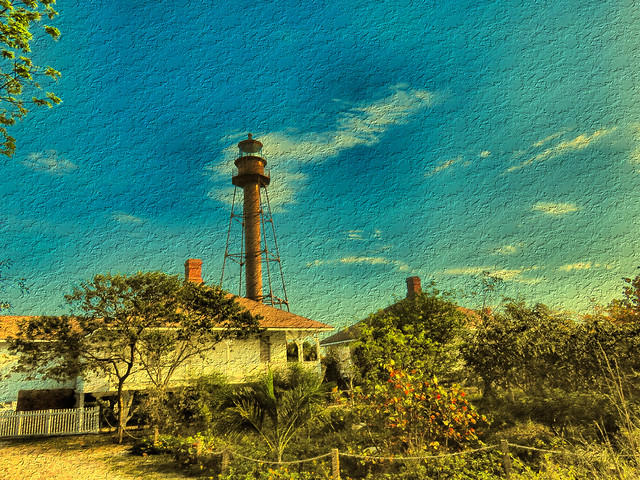
GOOD NEWS! IMPORTANT UPDATE to my April 14 post "Bald Eagles hatch second brood-- BUT..."
Remarkably, one observer provided a photo of two eaglets on the nest five days after another photographer witnessed (on April 11) what she interpreted as the smaller/younger of the two being killed. She saw and documented a struggle between both siblings. Her photo clearly showed what appeared to be the lifeless form of the smaller one sprawled over the rim of the nest. Here is a link to her photo:
The subsequent observer wrote: "At 09:15 today [April 16] I saw and photographed both eaglets. They were both alive, and moving throughout the nest and doing well. Mom was also in the nest..." His photo showing the two may be viewed here at this link.
At first I wondered whether the "dead" eaglet may have been a third and even younger nestling, but what I now think that this represented a defensive instinct which protected the weaker sibling from further attack.
I have seen this kind of behavior in small birds when a hawk suddenly appears. Usually the birds scatter into protective shrubbery and remain perfectly still. If surprised out in the open they may "freeze" in place as long as the threat is present.
As a kid I often helped my grandfather catch chickens which roamed in our adjacent backyards. If I cornered one by extending my hands in front of it (almost like a hawk swooping down) it would suddenly become motionless, crouching low. I could pick it up and even turn it on its back without it trying to escape. See "How to Hypnotize a Chicken" in the The Old Farmer's Almanac at this LINK.
= = = = = = = = = = = = = = =
Linking to Misty's CAMERA CRITTERS,
Linking to Eileen's SATURDAY'S CRITTERS,
Linking to GOOD FENCES by Tex (Theresa).
Linking to SKYWATCH FRIDAY by Yogi, Sylvia and Sandy
Linking to WEEKEND REFLECTIONS by James
Linking to BirdD'Pot by Anni
Linking to Wild Bird Wednesday by Stewart
________________________________________________
Please visit the links to all these memes to see some excellent photos on display
________________________________________________
This continues my monthly retrospective on past experiences, memories from three years ago. I will continue to search the archives for photos which represent a few selected themes: Living CRITTERS of all kinds, beautiful SKIES and REFLECTIONS, as well as MACRO images and GOOD FENCES. I have met this challenge for the past 15 months in a row, so let's see how far I must travel into the month of April, 2013 to achieve my goal!
I started the month out right, while observing the local Bald Eagle nest, as a pair of Red-shouldered Hawks landed atop a light standard along the road (April 1, 2013):

The next morning the female eagle provided a nice fly-by photo opportunity:

A not-very-handsome "critter" was reluctant to get out of our path on April 8. This Opossum had not quite finished eating a rat which had been killed by the mowers, as its tail still protruded from its mouth:

The juvenile Bald Eagle was still returning to the nest to be fed:

A Marsh Lily provided a nice macro study:

On April 14 we visited a ranch in Hendry County to the north, where Barred Owls had a nest, ...

...a Swllow-tailed Kite flew overhead...

...and a wild sow shepherded her piglets:

At the ranch we also saw a Crested Caracara,...

...Wild Turkeys,...

...Burrowing Owls,...

...and Roseate Spoonbills:

So far, we have seen a plethora of "critters," but I could not pass by this Gray Squirrel in our front yard:

Thanks to the breezes which produce ripples on our Florida lakes, we are halfway through the month without a single nice reflection. Now we return to Illinois, to find a restless sky over the entrance to Nelson lake Forest Preserve, ...
 ...and on April 29 find a fledgling Great Horned Owl in a local park...
...and on April 29 find a fledgling Great Horned Owl in a local park...

...as well as a weak excuse for the reflection of a dabbling pair of Mallards:

Still no fences, unless Theresa allows me to count this poor imitation of one in a construction zone, with a Tree Swallow beautifying its post:

If you squint while looking as the flood water recedes in Jones Meadow Park, you may see another fence in the distance:

On April 28, another macro-- a White Trout Lily:

On the last day of the month, a Northern Waterthrush cast its true reflection in a brook, but can you see either? (click to enlarge)





























































